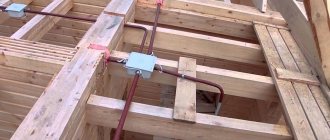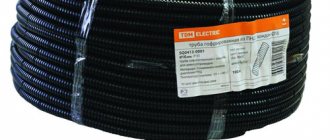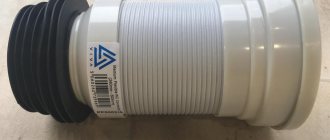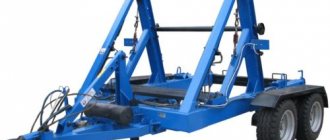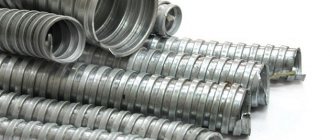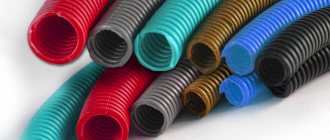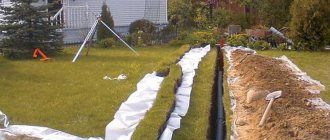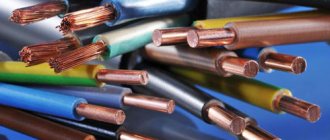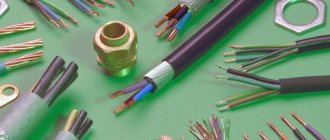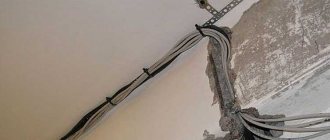Do you want to protect electrical wires by putting a corrugated sleeve on them during installation? Protecting the cable from damage, as well as additional insulation in case of damage to the braid around the cores in home electrical networks, is not superfluous, right?
But you don’t know how to properly install flexible corrugation for electrical wiring, but you don’t want to invite a professional electrician for this work?
We will tell you how to install a corrugated hose - the article highlights the intricacies of its installation, and examines the existing options for such electrical pipes made of different materials with their pros and cons.
The article is equipped with thematic photos, tips on choosing corrugated hoses and video recommendations for laying wires on your own. This will greatly simplify installation and dismantling work.
Why do you need a corrugated hose?
Installing electrical wiring is a responsible matter that does not tolerate mistakes. The safety of staying in electrified premises directly depends on its quality.
The benefits of civilization in the form of glowing light bulbs and numerous household appliances, by definition, cannot work without being connected to the power grid.
And any live electrical cable is a source of damaging current that is dangerous to humans.
It is recommended to use corrugated cables for electrical wires everywhere (for hidden and open installation methods, for installation outdoors and indoors). If this is not possible for aesthetic reasons, then it should be replaced with a decorative cable channel
The first protection against electric shock is the insulating braid of the cable itself. Regardless of the material used, it reliably protects a person from the current flowing through the veins.
However, insulation does not last long. These aluminum or copper wires can last 15–25 years, but the outer braid on them is often damaged within 3–4 years after the wiring is put into operation.
The service life of electrical wire insulation is greatly reduced due to:
- high humidity (outdoor or room);
- overheating under increased loads;
- ultraviolet radiation and other factors.
The result is a breakdown, short circuit, fire and electric shock to a person. To minimize risks, electricians lay wires in a corrugated sleeve.
On the one hand, it serves as an additional barrier between electric current and a person, and on the other hand, it serves as protection for the cable.
If the need arises to replace the old wire in the corrugation, it is simply pulled out of the sleeve, and a new one is inserted in its place - and it does not matter whether this channel is located under the finishing or in a concrete screed
A cable laid in a corrugated pipe receives protection from:
- compression and other mechanical damage;
- ultraviolet radiation and precipitation (when laying wires outdoors);
- exposure to moisture.
And the last thing is fire safety. All corrugated hoses for electrical cables are made of non-flammable or self-extinguishing materials.
This reduces the likelihood of exposure to an open flame on the wire inside the corrugation, and also prevents the spread of fire during short circuits and fires of the plastic cable braid.
pros
Stainless corrugated piping technology is attractive for the following reasons:
- The product is not subject to corrosion due to the metal - ordinary, stainless or galvanized steel. Stainless steel corrugation has the highest corrosion resistance.
- An important property of pipes is durability. The service life of the system is virtually unlimited, and is determined by the service life of the couplings used for crimping. Some parts (O-rings) are designed to last 50 years.
- Economical technology. Construction budgets are saved due to overall low metal consumption and reduced assembly time. According to experts, costs are reduced by 20-25%.
- The products are ideal for organizing heating and plumbing systems. A stainless steel corrugated pipe for water supply has characteristics that allow it to cope with temperature fluctuations (up to freezing of the coolant) and water hammer.
Flexibility is one of the main advantages of corrugation Source amazon.com
- Practicality during use. The pipes are flexible and resist static and dynamic loads well. Bends do not affect the permeability, therefore, when using corrugated products, you can avoid fittings (connecting parts).
- The weight of corrugated pipes is insignificant, comparable to some types of polymer analogues.
- Due to the high heat transfer coefficient of metal, corrugated pipes are effective in heating systems.
- The smooth inner surface prevents the section from overgrowing; hydraulic resistance remains minimal. Pipes do not require additional flushing.
- Installation is as easy as possible; Standard fittings are used for connections. Thanks to its flexibility, utility lines can be laid in hard-to-reach places. The number of connections has also been reduced.
Material with a polymer shell of different colors Source atmosfera.ua
Types of corrugations for electrical cables
Corrugated hoses for electrical wiring are made from various plastics and metals. There are also composite options made of iron wrapped in a layer of PVC.
It is recommended to choose one sleeve for the street, another for installation in a screed or ground, and a third for installation behind interior cladding.
If the wiring is laid in a dusty room and the channel for it requires a sealed one, then it is best to take a plastic sleeve - the joints between it and distribution panels and boxes are much easier to seal
All corrugations based on strength, wall thickness and design are divided into:
- lightweight (withstand loads up to 320 N/5 cm2) – thin-walled, flexible and fragile, designed for installation under sheathing on ceilings and walls;
- medium (designed for loads up to 750 N/5 cm2) – recommended for installation in wall grooves;
- heavy (withstand up to 1250 N/5 cm2) – thick-walled and rigid, used when installing wires in screeds on the floor;
- super-heavy reinforced (designed for 4000 N/5 cm2 and above) - hoses made of twisted steel wire and plastic sheaths, needed for laying cables underground and on the streets by hanging.
The thinner the walls of the corrugation, the softer and more flexible it is. However, as the flexibility of a corrugated hose increases, its resistance to mechanical damage decreases. At the same time, it is difficult to bend a pipe that is too thick at a right angle; it may simply break.
But such heavy corrugated hoses provide more reliable protection from moisture and dust. This is especially true when laying cables in the ground.
Type #1 - metal hose
When compared to plastics, metal is obviously a more advantageous option in terms of strength. It perfectly protects the cable from chemicals, moisture, ultraviolet radiation, shock and compression. And in the event of a fire, a metal hose will last much longer than its plastic counterpart.
A corrugated metal hose is more fireproof and reliable than its plastic competitor, but it should not be laid in the ground - rust will inevitably do its dirty work
Metal corrugations for laying cables are divided into several types:
- RZ-Ts, RZ-TsKh, RZ-TsA – made of galvanized steel.
- RZ-SL and RZ-SL-X - made of tinned steel tape (tin plated with tin).
- RZ-TsP – with PVC insulation.
The letter “X” in the first two options indicates the presence of a cotton seal, and “A” an asbestos-cement seal. The "P" in the latter type of corrugation indicates the outer layer of PVC.
Also, metal hoses for wires exist with flanges at the ends and welded ends. Plus, there are variations of high pressure hoses in explosion-proof versions and for high pressure.
However, such corrugated pipes are more intended for industrial conditions. They are not used for installing electrical wiring in the house due to their high price and fundamental uselessness.
Conventional metal hoses are made from steel tape by winding it in a spiral. At the same time, the resulting corrugation is not airtight. When pressed firmly, the joints of the tape immediately separate and the sleeve simply falls apart.
The metal hose is ideal for installing electrical wiring in a wooden house and outdoors; here its main advantage (non-flammability) comes in handy
If you need a sealed metal sleeve, you should take a product with additional insulation made of polyvinyl chloride. In this case, the top layer of self-extinguishing plastic will definitely prevent moisture and dust from reaching the steel base.
Only such corrugations are recommended for use in bathrooms and outbuildings, where constant changes in humidity and temperature are the norm.
Type #2 - polyvinyl chloride (PVC)
Gray electrical corrugations made of PVC are characterized by low price and self-extinguishing. In the event of a fire, they not only do not burn, but thanks to the additives in the plastic, they go out on their own.
The main disadvantage of any polyvinyl chloride products is their poor tolerance to UV rays. Under the influence of the sun, this material begins to simply “deteriorate,” which sharply reduces their actual service life.
Corrugated PVC pipes should be used exclusively indoors for wiring electrical wires using hidden technology, laying them behind cladding or other decor.
Another disadvantage of PVC corrugated sheets is their intolerance to low and too high temperatures, as well as excess humidity. When frozen, this plastic becomes brittle. In the cold it is destroyed even from a slight blow.
And in extreme heat (and even if in the sun), the corrugated polyvinyl chloride sleeve begins to soften slightly and “flow”. This does not lead to its immediate destruction or damage, but its service life is sharply reduced due to such operating conditions.
The situation is similar with water. With constant exposure to moisture, the walls of such corrugations begin to gradually collapse.
These PVC pipes for water supply are initially designed for such an impact, but corrugated hoses have slightly different characteristics.
If the wiring needs to be laid in the bathroom or outdoors in direct sunlight, then it is better to look for another cable channel option for it.
Corrugated PVC pipes are ideal for installing wires in dry, heated rooms. They are cheap and flexible, and installation should not be difficult. But their gray appearance frankly does not please with its presentability and aesthetics.
It is best to cover such corrugations on top with finishing (wall panels, plaster with wallpaper on top or clapboard).
Type #3 - polyethylene and polypropylene
Corrugations made from HDPE polyethylene (or LDPE) and PPR polypropylene are approximately equal in cost and characteristics. They are resistant to strong moisture, temperature changes and ultraviolet rays.
Such corrugated sleeves are universal. They can be used both indoors and outdoors.
In many properties, polypropylene and polyethylene are similar, their main difference is that PP cable sleeves are self-extinguishing, while PE sleeves are flammable
Both versions of these electrical corrugated hoses feel comfortable at air temperatures in the range of -40...+45 degrees Celsius. At the same time, HDPE is famous for its resistance to oils, acids and solvents.
It is recommended to use corrugated products made from it in garages, utility rooms and on the streets - that is, anywhere where aggressive technical liquids can get on the wires.
Cable corrugation, sizes, prices
Corrugated pipes for electrical networks are available in sizes from 16 mm to 65 mm. When choosing a size, you need to take into account that these products have two diameters - outer and inner. If you are going to lay several conductors - wires or cables - the diameter must be selected so that there is a clearance of at least half the radius. This requirement is based on the fact that when installed in groups (it is necessary, by the way, to take a special cable), it will heat up more and the presence of an air gap will contribute to better heat dissipation.
The price of corrugated electrical pipes depends on many factors
Size selection
The choice of corrugation diameter also depends on the area where it will be laid:
- for lighting fixtures - 16 mm;
- to sockets and switches - at least 20 mm;
The size of the corrugation for the electrical cable is selected depending on the number and size of the conductors - from the main distribution box to the next box, from the shield - at least 25 mm;
- the connection between two electrical panels is at least 32 mm, and it is better to have a spare second line;
- passage through the floors with rigid corrugation of at least 40 mm in diameter;
- laying low-current cables (telephone, internet, antenna, etc.) - from 25 mm.
The diameter of the corrugation for laying the cable is selected depending on the number and cross-section of wires. Data for copper conductors are given in the table.
Table for choosing the diameter of the corrugation for cables and wires depending on the cross-section and number of wires
This information is for reference only, but you can use it as a guide. You can take a larger, but not smaller diameter.
Prices
Generally speaking, the cheapest is PVC cable corrugation, in the middle range - PP and HDPE, and the most expensive is metal corrugation. Moreover, the option with broaching is slightly more expensive than without it. When purchasing, you need to pay attention to the same wall thickness and color uniformity.
Different materials, colors, wall thicknesses and different prices
Corrugated cables are sold in coils of 50 and 100 meters, less often you can find them in meters, but the price is then a little higher. In general, the price depends not only on the material, but also on the wall thickness. The cheapest is lightweight PVC corrugated cable, but sometimes it looks more like just a film. It’s hard to say what this can protect against. If you care about quality, it is better to purchase everything related to electrical equipment not in construction supermarkets like Leroy, etc. and in specialized ones. The quality there is usually better, and the prices, if higher, are reasonable. To give you an idea of the possible price range, we will summarize several types of corrugation with brief technical characteristics in the table.
| Name | Type | External diameter | Inner diameter | Broach | Price per meter | IP | Purpose |
| PVC corrugation | light | 16 mm | 11.4 mm | Yes | 2.4 RUR | ||
| Black corrugated HDPE pipe | DKS | 15.7 mm | 11.3 mm | Yes | from 7.5 rub/m | 55 | for hidden installation |
| Black corrugated HDPE pipe | DKS | 19.5 mm | 14.5 mm | Yes | from 8.9 rub/m | 55 | for hidden wiring |
| HDPE red double-wall pipe | tough | 50 mm | 41.5 mm | Yes | 78.5 rub/m | 44 | for hidden installation |
| HDPE pipe is heavy | heavy | 31 mm | 23.4 mm | Yes | from 9.7 rub/m | 55 | hidden gasket |
| PPL (polypropylene) corrugated pipe | light | 19.7 mm | 14.8 mm | Yes | from 28 rub/m | 55 | open, hidden gasket |
| Corrugated pipe polyamide | black | 21.2 mm | 16.8 mm | No | from 52 rub/m | 68 | open, hidden gasket, UV resistant |
| Corrugated pipe polyamide | gray | 21.2 mm | 16.8 mm | Yes | from 48 rub/m | 68 | open, hidden gasket |
Nuances of choosing and installing corrugated channels
Plastic corrugations for cables are available in various colors. Gray ones are usually made of PVC, black ones are made of polyethylene, and blue ones are made of polypropylene.
But there are no strict rules in terms of color. Each manufacturer adds dye to the polymer when making corrugated pipes at its own discretion.
However, there is an international standard for the coloring of such products and the wires in them, which provides for the choice of color in accordance with the purpose of the cable route.
White wires and corrugations are recommended to be used for computer networks, gray and black for general purposes, green for telephone lines, and red - exclusively for external street installation.
Following these recommendations greatly simplifies the life of electricians when they come to carry out repairs in an unfamiliar place. So the direction of each line is immediately clear.
It is strictly forbidden to lay several types of cables with different purposes in one corrugated hose; it is better to use a separate pipe for each wire
Installation of corrugations and electrical wiring in them is carried out in five stages:
- The corrugated sleeve and cable are cut into pieces of the required length.
- Using a cable stocking, a built-in broach, or a wire simply inserted into the pipe, the wire is pulled into the corrugation.
- Sleeves with a cable inside are fixed in a groove, on the floor or wall.
- The laid and secured corrugations are connected to the inlet holes on the bodies of boxes, panels and socket boxes, or simply inserted into them, and the wires are led out.
- Next is the usual electrical installation of devices connected to the electrical network.
To simplify the installation of electrical wiring, you should look for a corrugated hose on sale with a special harness (broach) inside. This is ordinary wire that was pre-strung through a corrugated pipe at the factory.
Only when cutting the corrugation you need to be careful so that this broach does not go inside. The cable on it for pulling into the sleeve is secured using ordinary electrical tape.
You can handle pulling the cable into the corrugated channel even alone, but doing this procedure with two people is much easier.
The metal corrugation must be grounded. And this should be done on both sides of the sleeve.
The internal diameter of the corrugated pipe is selected by doubling the total cross-section of all cables laid in it. This is necessary both to simplify installation and to prevent overheating of the wires inside.
The corrugation must fit flush into the body of the socket, switch or panel. Any “peeking out” of the cable or breaks between the end of the pipe and the body of the installation or distribution device are unacceptable.
In this case, you can forget about protecting the wiring with a corrugated sleeve. Such incorrect installation will only take time and money, it will be of zero use.
No. 3. Design features of corrugated pipes
Corrugated pipes are divided into:
- single-layer;
- two-layer.
With single-layer pipes, everything is clear just by the name. Two-layer ones require the presence of an outer corrugated layer and an inner smooth one. The latter are used less frequently, but make it possible to provide the cable with even higher resistance to mechanical loads.
A probe may be located inside the corrugated pipe . This is a steel wire that runs along the entire pipe. The probe greatly facilitates the process of tightening wires into the corrugation. You can find a corrugated pipe on sale without a probe . It costs less, but you will have to struggle with tightening the cable into it.
Conclusions and useful video on the topic
So that you can understand in all the nuances the types of corrugations for low-current and electrical cables, we have made for you a selection of video materials on this topic.
After looking at the reviews and installation descriptions below, you definitely won’t have any questions about the need, types and features of performing electrical installation work using corrugated hoses.
The importance of installing additional insulation on electrical wiring in the form of a special corrugation:
Pulling wires through a corrugated hose in detail:
Overview of different types of electrical installation corrugations:
Cable ducts in the form of corrugated sleeves are extremely easy to install. They are inexpensive, and the benefits of such additional protection for wiring are enormous . The cost of repairs in the event of a fire caused by a short circuit will obviously be higher. Pulling a cable through an electrical installation sleeve looks complicated only at first glance. Everything can be done independently.
Very often, electricians, having made the absolutely right decision to lay the electrical wiring cable in a corrugated area, make many violations and mistakes during this installation.
Let's consider the main ones, as well as common misconceptions associated with corrugation.
The first thing to note is the color of the corrugation. No one ever paints a corrugated sleeve on purpose, except in isolated cases of its decorative use.
Moreover, each color indicates the material from which the product was made.
- gray color is PVC - polyvinyl chloride
To ensure that it looks perfectly smooth and beautiful when mounted on the ceiling, experienced electricians advise buying it not in twisted coils, but in whips.
- black and orange color is HDPE - low-density polyethylene
- blue color PP – self-extinguishing polypropylene
Technical characteristics of PVC, HDPE, PP corrugated pipes:
Many have probably come across beautiful photos and videos where black and orange corrugations spread across the ceiling.
Everything looks beautiful, no doubt about it. And HDPE corrugated material itself, although it costs a little more, is much stronger than PVC. Although it all depends on the brand.
This simplifies its installation and eliminates the possibility of accidental damage. However, such beauty is a ticking time bomb.
The danger is that both orange and black corrugations support combustion very well.
In this case, a fire in an apartment may not start due to a short circuit or overload in the electrical wiring. And now imagine that your entire ceiling is simply covered with such material.
It is enough for one tube to catch fire and the fire will be of such a scale and category that there will be nothing left of the apartment or house.
Your main task will not be to put out the fire, but at least to get out of there safe and sound. And the chances will be slim, given the fiery rain of burning molten polyethylene.
In addition, it is this corrugation that will cause the fire to move from one room to another. In those places where the wiring passes through a concrete wall into another room, the flame can easily penetrate there by spreading the combustion of the HDPE corrugated hose. There will be no problems with PVC.
Because as long as it is exposed to fire, it burns. As soon as the fire is removed, it immediately goes out, because... does not support combustion.
Therefore, gray PVC corrugation should be used in apartments and houses. Multi-colored can be used for embedding into walls and concrete, but not for open laying.
Black HDPE corrugation can and should be used outdoors. Not gray, but colored.
It was created to provide protection from ultraviolet radiation. PVC will crack over time and will not provide protection.
But don’t listen to all sorts of stories from installers that it’s ideal to use colored marks to wire low current and power circuits.
For the installer, this may be convenient during the work process, but you will have to live with this fire-hazardous material for the rest of your days.
"Fire-fighting" properties of corrugation
Another common misconception is that corrugation is believed to have fire-fighting properties. Very often you can encounter a situation where corrugation is laid on combustible bases behind suspended ceilings.
Or they are even used instead of a steel pipe for hidden installation of electrical wiring in wooden houses.
Do not forget that the corrugated tube is designed to protect the cable from external influences, but does not have any localization ability. In case of short circuits, no corrugation or even a metal hose can save you. The fire will find a way out.
Here is a visual test of plastic corrugated hoses, not with an open flame, as everyone else does, but with hot wire. That is, when the cable is not yet on fire, but has only become as hot as possible due to overloads or a short circuit:
The question is, how will such “protection” save your wooden structures in the event of a circuit breaker failure?
Hidden electrical wiring on combustible substrates must be laid in a steel pipe with localization ability, or using a layer of non-combustible material such as gypsum plasterboard, using false walls.
Some people wonder, where can a short circuit in the middle of the cable come from? There are most often two reasons:
- rodents
- manufacturing defects
While a metal hose can somehow save you from rodents, it won’t protect you from manufacturing defects.
If you think that by laying all the wiring in the corrugation you can easily and simply change it if necessary in the future, then you are again mistaken.
Here we can talk about replacement only for cables on absolutely flat areas. For example, in a straight line from one junction box to another, or a descent from the junction box under the ceiling to the socket box below.
Once you take at least one turn at an angle of 90 degrees on the highway, replacing the wiring will turn into a complete torment. And if there are two turns, then simply forget about such a thing as turnover.
It doesn’t even matter that this will be a minimum distance of 2 to 2.5 meters. A high-quality cable is so rigid that even with a corrugation diameter of 20mm it will be practically impossible to do this.
You may need such force that the cable will pull itself out along with the corrugation from under the layer of plaster. Those who, instead of VVGng, use multi-core flexible wires of the PVS type and say that everything changes and stretches wonderfully, simply violate all current standards and rules.
Under no circumstances should you listen seriously to such advice.
Metal corrugated for electrical wiring
A corrugated metal pipe is a special protective channel for wiring that is hollow inside. Tubes are often made from galvanized steel, which ensures their moisture-proof properties.
Corrugated pipes are used in the following cases:
- Laying electrical cables behind or on top of flammable panels: frames, wooden panels, lining, polymer finishing materials.
- Laying a metal corrugated hose for electrical wiring in a cement floor screed or other concrete structures. In addition to mechanical protection of the cable from compression, the pipe allows, if necessary, to replace old wires with new ones without dismantling the monolithic filling.
- Installation of electrical wiring in an open way from the street side: powerful cables for lighting, complex equipment, etc.
- Installation of underground power supply systems.
- The wiring arrangement is close to gas pipelines and heating communications.
- Parallel cable routing to avoid cable crossings.
According to the PUE (clause 2.1.64), the metal corrugation for wiring must be completely sealed.
Increased cost of work
Let's figure out whether corrugated installation really leads to a significant increase in the cost of repairs.
For ease of installation of electrical wiring, many use round NYM cable, including VVGng with a round cross-section. At the same time, they tighten it into the corrugation d=16mm.
After which you need to prepare a 20mm*20mm groove. If you have a wall chaser, the width of the groove when installing the disks does not particularly affect labor costs.
Many people initially set the cutting depth to 25mm to make it easier to cut the middle of the furrow. The shallower the cutting depth, the harder the core chips.
Therefore, in order to lay the bare cable in the groove, you will still have to cut a strip approximately 20mm deep. Or work very hard with a hammer drill, which will ultimately lead to no less labor costs.
At the same time, do not forget one important nuance - gating in load-bearing walls in panel houses and hollow-core slabs is prohibited.
And where the cutout is not made in load-bearing walls, firstly, the integrity of the reinforcement should not be compromised, and secondly, the depth of the cutout should not exceed 20mm.
Therefore, when we talk about cutting a groove in a wall, in 90% of cases we mean cutting a groove in the plaster. The problem is that not everyone wants to apply 2.0-2.5 cm of mixture to the walls, just because of the wiring.
However, there is still an increase in cost when working with corrugation, and for many it can be critical. When working with this material you need:
- special fasteners and nails
Using a mounting gun, on average it takes 3 shots per 1 meter of corrugation.
If you use boxes with 4 separate inputs, then without corrugation you can place a much larger number of cables there. But when working with corrugation, there are only four!
Therefore, the total number of boxes, although not significant, will increase.
It was already said above that the gating itself does not increase costs so significantly, but if we talk about drilling through holes through the walls, then everything can change significantly.
If you drill one hole d=32mm, you can easily pass 4 bare cable lines through it. But for the same quantity, but already in a corrugation, you will need to drill at least 4 holes.
When working in an apartment with soft partitions, this point is not critical. But if you try this in a private house, or in a panel high-rise building with high-quality concrete walls, your labor costs will increase many times over.
For many electricians working alone, it can take a whole day of work just to punch through holes.
Therefore, yes, in some cases, depending on the working conditions and the specific object, the increase in the cost of laying cables in corrugated cables can be at least 30%. And for some, this is a significant difference in the total cost of repairs.
But can corrugation, on the contrary, help save a lot? Surprisingly yes.
Here is a very original use of it for securing a cable in a groove. Thanks to it, you can completely eliminate the cost of dowel clamps.
In this case, you can even use the remains of corrugated hoses, which are no longer needed anywhere.
Corrugated HDPE or PVC for wiring, which is better?
- When laying in flammable walls (wood or frame), for flammable finishing (lining, PVC boards), when attaching to a wooden floor - for fire safety reasons. In this case, choose non-flammable casings.
- When laying behind finishing materials - behind lining, plasterboard, PVC boards, etc. - for security reasons. To make it more difficult to damage the cable when trying to hang something on the wall. In this case, the most important indicator is the hardness of the shell.
Errors and rules for installing corrugated cables
- do not create sharp corners when designing routes
- To increase the length of a single piece of corrugated tube, use special transit boxes, tees and couplings
Do not connect the tubes to each other using electrical tape. Install connecting accessories at turns, corners and closer to the middle of the entire area.
- You cannot stretch several cable lines in one corrugation at once
- power networks and low current must be separated from each other, maintaining appropriate distances
- if you are not running a cable in a corrugated pipe, but individual wires, here is a table for selecting the maximum cross-section of conductors and their number, depending on the diameter of the tube:
Recommended corrugation diameters for different networks:
- Corrugation d=16mm is usually used on the lighting line
- for power sockets with a diameter of at least 20mm
- for coaxial cable for video surveillance – no less than 25mm
- for low current (telephone, internet, TV cable, alarm) D=16mm
Corrugation for wires and cables provides excellent protection against damage. This device will be needed when pulling cables underground or when conducting electrical wiring inside a building. Corrugated pipe is an important attribute of any hidden wiring. We will tell you how to choose it wisely in this article.
The safety of the entire building depends on the quality of such products.
Advantages of corrugated pipes
Attaching the cable to the wall
The advantages of additional protection of wires and cables in the form of a corrugated sheath are as follows:
- PVC corrugated pipes are non-flammable, light weight, and easy to install;
- Pipes made of stainless steel and aluminum are flexible, have high strength, and are resistant to corrosion.
- Polyethylene corrugated pipes do not support combustion and can withstand high external pressure.
- Corrugated pipes, regardless of the material of manufacture, retain the outer insulating layer of electrical wiring for many years.
- When replacing one of the cables, it is not necessary to perform particularly complex dismantling work on straight sections. The damaged wire is pulled out of the pipe, and new electrical wiring is installed in its place.
- The corrugated pipe takes the load from the weight of the cables along the entire length of the pipeline, which eliminates sagging of the electrical wiring if the distances between the support points are correctly selected.
Corrugation for wires: design and materials
Corrugated pipe for cable is used for installation of all kinds of lines, as well as for various wiring options: disguised, underground and external. They differ in their design, technology and raw materials.
The following types of materials can be used:
- HDPE is a flexible wire;
Application of HDPE material
- polyvinyl chloride is a self-extinguishing type of raw material;
- pnd is used for hidden lines. It is laid in concrete structures or bricks;
- polypropylene is a plastic line that is used to install the cable;
- polyamide provides good waterproofing.
Structure of a polyamide product
If the wiring is laid over flammable types of material, then heat-resistant metal corrugation is used. Pipes can have different designs. In the single-layer version, the main has one wall between the outer and inner surfaces. A two-layer product has an inner layer that is placed in a protective casing.
Corrugated wires are in demand due to many advantages:
- long service life;
- does not allow moisture to pass through;
- fire resistance;
- increased resistance to various types of load;
- does not corrode;
- light weight.
In what cases is corrugation used for laying underground cables?
Laying in a trench is the most popular method of installing a line leading from a power line to a house. Its advantages are reliability and aesthetics.
According to GOST
State standards and other regulatory documents do not contain a direct requirement regarding the use of corrugation. But there are indirect indications, for example:
- table 2.1.3 PUE recommends placing cables in pipes made of difficult or non-combustible materials;
- clause 7.1.37 of the PUE requires that the wiring be replaced, but this is impossible to do without the use of corrugation;
- Clause 3.58 of SNiP 3.05.06-85 obliges to protect lines from mechanical damage.
What is it for
The corrugation performs several functions:
- Protects the conductor from mechanical damage, moisture, ultraviolet radiation (for external installation).
- Makes it easier to replace the cable - no need to open the trench or groove.
- When laying underground - thanks to the red color, it signals the presence of a line when excavating a trench.
Pros and cons of using corrugated pipes for underground work
In comparison with asbestos-cement, steel and ceramic casings, corrugations have the following advantages:
- low cost;
- immunity to corrosion;
- dielectric strength of 2000 V with a resistance of 100 Ohms (the casing does not need to be grounded);
- moisture resistance;
- light weight;
- service life up to 50 years;
- flexibility: no bends are needed to organize turns on the route;
- ease of installation: the ends of small and medium-diameter products do not need to be soldered, which allows you to do without complex equipment.
Thanks to the ring rigidity, the corrugated shell does not collapse under the weight of the soil.
The only drawback of the plastic casing is flammability. But thanks to special additives, the product is classified as low-flammable and self-extinguishing.
Why are corrugated metal pipes for electrical wiring so popular?
The main purpose of metal corrugation for wiring is to protect wires from various damages. In residential premises, metal corrugated cables are used for cables that are routed over combustible surfaces. These are various electrical wiring above suspended structures, in outbuildings and wooden buildings.
Additional protection is important when the cable comes into contact with pipelines. This is important when crossing heating lines and gas pipelines. Laying electrical wiring inside a metal case is done in several steps:
- the wires are pulled inside the protecting line;
- installation of structures on surfaces and supply of wires to panel boxes;
- connecting cables.
The protective line is laid over various surfaces using clips. It is necessary to fasten at distances to prevent sagging. Pay attention to the installation of cables and wires inside electrical appliances. Condensation should not collect in the corrugation. When inserting electrical panels into structures, various couplings are used. Fittings are used to connect elements.
Application of metal lines for industrial purposes
Metal differs from similar options in increased strength. The following options are also available:
- plastic corrugation has excellent technical characteristics;
- the outdoor version is used for wiring outside, it is resistant to aggressive environmental conditions;
- Automotive pipe is used to preserve wires in cars;
- the product for pulling cables in the ground is wear-resistant and can be used for a very long time;
- Modern options include PVC construction;
- The heat-resistant version has an increased level of strength and is not subject to thermal effects.
Cable laying in the garage
The principle of laying cables underground
When laying a plastic pipe for laying cables in the ground, you must follow the following steps:
- The first step is to check the HDPE pipes. They must not be damaged in any way. The same applies to the pulled cable.
- Markings must be applied to the pipe laying areas.
- Now you can proceed to digging a recess of the required dimensions for laying the cable.
- Then comes the laying of the pipe itself.
- And now the cable is being pulled through the pipe. It should not be stretched inside.
- The entire structure must be buried with a layer of sand of 10 centimeters and a layer of soil of 15 centimeters.
- Signaling tape can be laid on top of the embankment. You can skip this step. The tape will act as a marking.
If you are installing a power cable, it is best not to use adapters and couplings at all. When this is not possible, their number should be kept to a minimum. The fact is that adapters and couplings will violate the tightness of the pipeline, which is so necessary for the power cable.
In those places where pipes emerge from the soil and enter the building, special fittings should be installed. What is the situation with the minimum cable cross-section for placement underground? It is best to take not the thinnest wires. For example, a cable with a cross-section of 4 mm or more is suitable.
If the above-described method of laying pipes with cable is not possible, then horizontal laying is used. Its implementation requires drilling. Among the advantages of this method is the absence of the need for land work. There is no need to dig a trench for communications.
To begin with, engineering surveys are carried out. This is the name for work on studying the soil characteristics in the area where construction is planned. Drilling cannot be carried out until the relevant documents have been received.
When you have the permit in hand, you can move on to the main part. It all starts with drilling a pilot well. A special drill with a radiating head is used, which easily destroys the soil. When it encounters a void, it fills with liquid. It is designed to cool the drill, and also prevents the collapse of the earth.
At the next stage, the well is expanded. To do this, put an attachment called a rimmer on the drill. Then you can proceed to tightening the pipe and wire into the well. A drilling rig is also used for this. This is the most critical stage of the work, and it is also the final one.
How to work correctly with corrugated pipe?
It is difficult for beginners to understand how to correctly route a wire through a corrugated pipe for electrical wiring. Although there is nothing complicated about this, you just need to follow certain steps:
- the required length is measured locally and cut, and then the wire is cut with side cutters;
- you need to hold the broach so that it does not get lost in the pipe;
- a tourniquet is made, which should be tight;
- the harness inserted into the corrugation must be attached to a metal broach;
- The joint areas are wrapped with electrical tape.
After placing the wiring, the corrugated pipe is fixed every 20 cm with special fasteners. The clamps are first attached to the corrugation, and then to the surface. A special device is used to pull the cable through the corrugation.
Stainless steel corrugation
Types of corrugated metal pipes
You can find the following types of tubes on the market:
- Stainless steel. They have the highest cost among the options presented.
- Galvanized. They contain a special fabric that ensures the integrity of the connection of the corrugation links.
- Steel with polymer (PVC) braiding. Designed for cable installation in places of increased explosion hazard, in soil, water. This type of pipe is characterized by increased tightness.
- Tin. The lightest type of metal corrugation. Relevant when installing electrical wiring in places with high humidity. The tightness of the link joints is ensured by a special polypropylene film.
Protective channels are always cut in one piece according to the length of the cable being laid. Joining two sections of the tube is not allowed.
What to consider when choosing a corrugated pipe
When choosing corrugations for wires, you need to consider some recommendations. Pay attention to the color scheme of the material. It is better to choose a color that is uniform and without inclusions. Since heterogeneity indicates that the product is made from recycled plastic.
To make the installation process easier, do not save too much and choose a tube without broaching. This is important for small diameter pipes.
Installation of multiple wiring
When purchasing accessories, do not forget about special fasteners for installing pipes. In this case, you can use clamps, clips and dowels.
Various types of cables are used in corrugated electrical wiring, so it is important to choose the correct sizes, which depend on the cross-section of the wires. For computer lines, a pipe with a cross-section of 16 mm is suitable, and for connections to sockets, a pipe of 20 mm is used. For power structures, pipes with a diameter of 25-55 mm are suitable.
Electrical wiring diagram option
In the table you can see how to choose corrugation taking into account the color scheme.
| White | For computer wires. |
| Grey | For any electrical wiring lines. |
| Black or brown | For various household units. |
| Green | For telephone lines |
| Red | For wires outside the building. |
| Blue | For underfloor heating structures and for water supply lines. |
| Yellow | Gas supply. |
According to fire safety, this material is divided into three categories:
- for installation on non-flammable surfaces made of concrete or brick, any pipes are used;
- LDPE and PVC corrugation are used in frame buildings;
- For installation in flammable structures, fire-resistant pipes are used. The use of plastic on such surfaces is prohibited.
Price of metal corrugation for cable
The average price for a corrugated meter cable varies from 10 to 800 rubles. The cost of a metal pipe will be higher.
In the table you can see the price for specific corrugation models.
The diagram shows the installation of a corrugated pipe using special fasteners
No. 6. Manufacturers of corrugated pipes for electrical wiring
When purchasing corrugated pipes, it doesn’t hurt to inquire about the availability of quality certificates. This is not a mere formality, but an important security requirement. It doesn’t hurt to look at the name of the manufacturer, since large companies will not risk their reputation and produce products of inadequate quality. Among the largest manufacturers of corrugated pipes, whose products are presented in domestic stores, it is worth noting:
- LLC "is a domestic enterprise that produces and sells a wide range of materials for electrical wiring, incl. produces corrugated pipe. The range includes products made from PVC, HDPE and PP, light and heavy pipes, with and without a probe, of different diameters. Production is standardized according to ISO 9001, and products meet all European requirements;
- JSC " RUVINIL " is one of the largest Russian manufacturers of electrical products. Since 1998, the company has mastered the production of a huge range of products, using modern technologies and high-quality raw materials. The company produces corrugated pipes from PVC, HDPE and LDPE with a diameter of 16 to 63 mm;
- is another fairly large domestic company that produces a solid range of electrical installation products. Corrugated pipes here are made only from PVC, diameter from 16 to 55 mm, there are products with and without a probe, light and heavy;
- Delta LLC produces products under the EnergoPlast brand. The assortment includes PVC and HDPE pipes, light and heavy, with and without a probe;
- Tyumen Corrugated Pipe Plant produces PVC pipes of various diameters;
- NASHORN - an enterprise that today is called one of the largest manufacturers of plastic pipes. For installation of electrical wiring, they only produce corrugated pipe made of PVC; the range is not very large.
Useful tips
To create safe and durable wiring when choosing a corrugated pipe and its installation, follow our tips:
- If possible, do not use sharp corners;
- when used in long networks, connect pieces of corrugation using transit boxes;
- in monolithic structures, the corrugation is installed before pouring, and the wiring is pulled after hardening;
- when carrying out hidden wiring, grooves are made in advance where the pipe will be laid;
- external wiring is hidden behind suspended or plasterboard ceilings.
Pulling wires under the roof
If you follow all the recommendations, you will be able to choose the appropriate corrugation option and make the correct installation of all electrical wiring.
Laying cable in a pipe under the road
In some situations, it is necessary to lay the cable under the road. This is a rather difficult method, which is used if it is impossible to dig a trench. A specialized organization that has the necessary equipment will be able to handle the drilling.
When choosing pipes, it is necessary to take into account the load that will be placed on them. If you plan to lay the cable under the road, near houses or industrial facilities, then it is best to choose the most durable products.
You must fully follow the installation rules. In this case, the cable will be maximally protected from environmental influences, and the HDPE pipe will not wear out prematurely.
